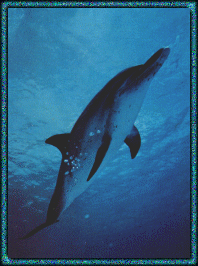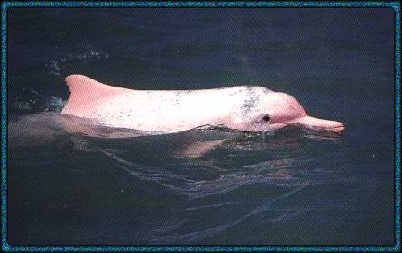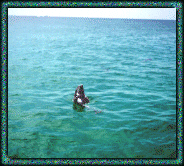 

Dolphins give live births with the young staying with their mothers for a year or more. They have been clocked at sea traveling at speeds of more that 25 miles per hour. The largest dolphins reach a length of about 15 feet, but most species are 7 to 10 feet. Dolphins are noted for their intelligence and learning abilities. Their social behavior and organization are among the most complex and advanced in the animal kingdom. They are able to detect objects underwater by using "echolocation" in which sounds are reflected off solid surfaces back to their sensitive ears. They also communicate among themselves as members of a pod. They are relatively long-lived, with some living more that 20 years. River dolphins are native to South America and southern Asia. The Ganges and Indus dolphins inhabit the large rivers of the Indian subcontinent. The Whitefin dolphin inhabits the Yangtze river of China. The Amazon dolphin inhabits the Orinoco and Amazon Rivers. One of the most well known species is pictured to the right - the Bottlenosed Dolphin (Tursiops truncatus).
The Boutu dolphin (Inia geoffrensis) is a freshwater dolphin found in the Amazon and Orinoco rivers in South America. The most distinctive feature of these animals is as they become older their skin color becomes pink, particularly on the underside.  In Hong Kong's western harbour, a population of around 120 Indo-pacific Humpback Dolphins, or Chinese White Dolphins (Sousa chinensis) are fighting to survive against a barrage of threats: pollution, habitat loss, overfishing, and boat traffic. As you can see from the picture, this dolphin is also pink. People who have seen both say they're even pinker than the South American Boutu. Although Sousa chinensis is found from South Africa to North Australia, this coloration is unique to Southeast Asia. There are many more species of dolphins, and each is equally fascinating in their own way. 
References
 Site Map Ocean Dreams Email at: dh @ naturehaven.com (Take out the spaces and this email address will work!) Please Read Guestbook ~~~ Please Sign Guestbook  |
 Dolphins are small members of the whale order, Cetacea. Modern cetaceans, wholly aquatic, probably evolved from land mammals 60 million years ago during the Paleocene era. Biologists recognize distinct families: the true dolphins, with more than 30 marine species, and the river dolphins, with 5 freshwater species. Dolphins are the most abundant and varied of all cetaceans. They have numerous conical or spatula-shaped teeth in both upper and lower jaws. Most, though not all, have a dorsal fin. They are mainly fish-eaters. Feeding in upper waters, and surfacing to breathe several times a minute.
Dolphins are small members of the whale order, Cetacea. Modern cetaceans, wholly aquatic, probably evolved from land mammals 60 million years ago during the Paleocene era. Biologists recognize distinct families: the true dolphins, with more than 30 marine species, and the river dolphins, with 5 freshwater species. Dolphins are the most abundant and varied of all cetaceans. They have numerous conical or spatula-shaped teeth in both upper and lower jaws. Most, though not all, have a dorsal fin. They are mainly fish-eaters. Feeding in upper waters, and surfacing to breathe several times a minute. I took this picture off the coast at Panama City Beach, Florida. This dolphin is found around the world except in coldest waters. They have been known to leap clear of the surface of the water by as much as 15 to 20 feet.
I took this picture off the coast at Panama City Beach, Florida. This dolphin is found around the world except in coldest waters. They have been known to leap clear of the surface of the water by as much as 15 to 20 feet.